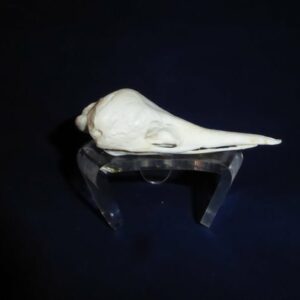All items sold on this website are polyurethane resin replicas, made in USA. No real or natural bone is available on this site.
Tachyglossidae Skull Replica measures 4.3 inches. Tachyglossidae Skull Replica is museum quality polyurethane cast. 2-part skull (separate cranium and jaw). Made in USA. Known as Short-Nosed Echidna.
Our precise skull can be used as a teaching tool, museum skull exhibit, home décor skull, or office décor skull.
Short Beaked Echidna or Montremata spiny, sometimes known as Spiny Anteaters or Short Beaked Echidna, belong to the family Tachyglossidae in the monotreme order of egg laying mammals.
Tachyglossidae is a egg laying anteater of Australia, Tasmania and New Guinea.
The Short Beaked Echidna or Tachyglossus aculeatus is one of four living species of echidna and the only member of the genus Tachyglossus.
It is covered in fur and spines and has a distinctive snout and a specialized tongue, which it uses to catch its insect prey at a great speed.
Tachyglossidae feed mainly on ants and termites though they have been known to eat other invertebrates. They generally feed during early morning and late evenings.
They have an acute sense of smell which they rely on to detect food. Once the food is located they use their long sticky tongue to catch their prey. Echidnas have no teeth, so instead grind their food between the tongue and roof of their mouth.
Like the other extant monotremes, the Tachyglossidae or Short Beaked Echidna lays eggs; the monotremes are the only group of mammals to do so.
The Short Beaked Echidna or Montremata spiny has extremely strong front limbs and claws, which allow it to burrow quickly with great power. As it needs to be able to survive underground, it has a significant tolerance to high levels of carbon dioxide and low levels of oxygen.
The Short Beaked Echidna or Tachyglossus aculeatus has no weapons or fighting ability but repels predators by curling into a ball and deterring them with its spines.
It lacks the ability to sweat and cannot deal with heat well, so it tends to avoid daytime activity in hot weather. It can swim if needed. The snout has mechanoreceptors and electroreceptors that help the echidna to detect its surroundings.
During the Australian winter, the Tachyglossidae goes into deep torpor and hibernation, reducing its metabolism to save energy. As the temperature increases, Short-nosed echidna or Tachyglossus aculeatus emerges to mate.
Female Short Beaked Echidna lay one egg a year and the mating period is the only time the otherwise solitary animals meet one another; the male Short-Nosed Echidna or Tachyglossus aculeatus has no further contact with the female or his offspring after mating.
The female echidna lays a single, soft-shelled egg in her pouch. The egg hatches after about 10 days and the baby Echidna, called a puggle stayes in the pounch for about two months. A newborn echidna is the size of a grape but grows rapidly on its mother’s milk, which is very rich in nutrients.
Tachyglossidae or Short Beaked Echidna Facts:
Scientific classification
Kingdom: Animalia
Phylum: Chordata
Class: Mammalia
Order: Monotremata
Family: Tachyglossidae
Genus: Tachyglossus
Species: T. aculeatus
Binomial name: Tachyglossus aculeatus
Conservation status: Least Concern


